new york architecture walks- Greenwich Village
|
Greenwich Village, which New Yorkers
invariably speak of simply as "the Village," enjoyed a raffish
reputation for years. The area was originally a rural outpost of the
city -- a haven for New Yorkers during early-19th-century smallpox and
yellow fever epidemics -- and many of its blocks still look relatively
pastoral, with brick town houses and low-rises, tiny green parks and
hidden courtyards, and a crazy-quilt pattern of narrow, tree-lined
streets (some of which follow long-ago cow paths).
In the mid-19th century, however, as the city spread north of 14th Street, the Village became the province of immigrants, bohemians, and students (New York University [NYU], today the nation's largest private university, was planted next to Washington Square in 1831). Its politics were radical and its attitudes tolerant, which is one reason it became a home to such a large lesbian and gay community. Several generations of writers and artists have lived and worked here: in the 19th century, Henry James, Edgar Allan Poe, Mark Twain, Walt Whitman, and Stephen Crane; at the turn of the 20th century, O. Henry, Edith Wharton, Theodore Dreiser, and Hart Crane; and during the 1920s and '30s, John Dos Passos, Norman Rockwell, Sinclair Lewis, John Reed, Eugene O'Neill, Edward Hopper, and Edna St. Vincent Millay. In the late 1940s and early 1950s, the abstract expressionist painters Franz Kline, Jackson Pollock, Mark Rothko, and Willem de Kooning congregated here, as did the Beat writers Jack Kerouac, Allen Ginsberg, and Lawrence Ferlinghetti. The 1960s brought folk musicians and poets, notably Bob Dylan and Peter, Paul, and Mary. Today, block for block, the Village is still one of the most vibrant parts of the city. Well-heeled professionals occupy high-rent apartments and town houses side by side with bohemian, longtime residents -- who pay cheap rents thanks to rent-control laws -- as well as NYU students. Locals and visitors rub elbows at dozens of small restaurants, cafés spill out onto sidewalks, and an endless variety of small shops pleases everyone. Except for a few pockets of adult-entertainment shops and divey bars, the Village is as scrubbed as posher neighborhoods. Greenwich Village lends itself to a leisurely pace, so allow yourself most of a day to explore its backstreets and stop at shops and cafés. |
|
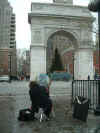
|
Begin your tour of Greenwich Village at the foot of 5th Avenue at Washington Memorial Arch in Washington Square Park. Most buildings bordering the leafy square belong to NYU. |
 |
On Washington Square North, between University Place and MacDougal Street, stretches The Row, two blocks of lovingly preserved Greek revival and federal-style town houses. |
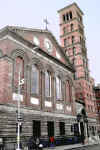
|
At the corner of Washington Square South and Thompson Street you'll see the square-towered Judson Memorial Church. |

|
One block east, at La Guardia Place, NYU's rebuilt student center stands on the site of a boardinghouse that had been nicknamed the House of Genius for the talented writers who lived there over the years: Theodore Dreiser, O. Henry, and Eugene O'Neill, among others. Another block east is the hulking red sandstone Bobst Library, built in 1972, which represents an abortive attempt to create a unified campus look for NYU as envisioned by architects Philip Johnson and Richard Foster. At one time plans called for all the Washington Square buildings to be refaced in this red stone; the cost proved prohibitive. On the east side of the square, you can take in a contemporary art exhibit at Grey Art Gallery, housed in NYU's main building. |
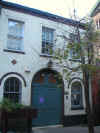
|
From Washington Memorial Arch and the park,
cross Washington Square North to the east corner of 5th Avenue, where
there's a portico entrance to 7-13 Washington Square North. Beyond the
white columns of this entrance is the small, attractive Willy's Garden.
A statue of Miguel de Cervantes, the author of Don Quixote,
stands at the far end. The likeness, cast in 1724, was a gift from the
mayor of Madrid.
Another half a block north, on the east side of 5th Avenue, is Washington Mews, a cobblestone private street. A similar Village mews, MacDougal Alley, lies between Washington Square North and 8th Street, one block west. |

|
Continue up the west side of 5th Avenue; you'll pass the Church of the Ascension, a Gothic revival brownstone building. |
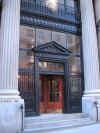
|
At 12th Street you can stop in the Forbes Magazine Galleries. |
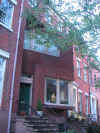
|
Backtrack to West 11th Street and turn right to see one of the best examples of a Village town-house block. One exception to the 19th-century redbrick town houses here is the modern, angled front window of 18 West 11th Street, usually occupied by a stuffed bear whose outfit changes day to day. This house was built after the original was destroyed in a 1970 explosion of a basement bomb factory, which had been started by members of the Weathermen, the revolutionary faction of the Students for a Democratic Society. Toward 6th Avenue, behind a low wall on the south side of the street, is the Second Shearith Israel graveyard, used by the country's oldest Jewish congregation after the original cemetery in Chinatown and before the one in Chelsea. |
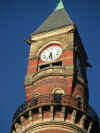
|
Turn left on Avenue of the Americas (6th Avenue) and go south one block. On the west side of the street, the triangle formed by West 10th Street, 6th Avenue, and Greenwich Avenue originally held a market, a jail, and the magnificent towered courthouse that is now the Jefferson Market Library. |

|
West of 6th Avenue on 10th Street is the wrought-iron gateway to a tiny courtyard called Patchin Place; around the corner, on 6th Avenue just north of 10th Street, is a similar cul-de-sac, Milligan Place. |
|
Next, proceed to Christopher Street, which
veers off from the south end of the library triangle. Christopher Street
has long been the symbolic heart of New York's gay and lesbian
community. Within a few steps you'll see Gay Street on your left.
Continue on to cross Waverly Place, where on your left you'll pass the
1831 brick Northern Dispensary building. At 51-53 Christopher
Street, the historic Stonewall riots marked the beginning of the gay
rights movement. Across the street is a green triangle named
Christopher Park, not to be confused with Sheridan Square,
another landscaped triangle to the south.
Across the busy intersection of 7th Avenue South, Christopher Street has many cafés, bars, and stores; several cater to a gay clientele, but all kinds of people traverse the narrow sidewalks. Two shops worth a visit are McNulty's Tea and Coffee Co. (No. 109), with a large variety of tea and coffee blends, and Li-Lac Chocolate Shop (No. 120), a longtime favorite for its homemade chocolate and butter crunch. West of 7th Avenue South, the Village turns into a picture-book town of twisting tree-lined streets, quaint houses, and tiny restaurants. Starting from Sheridan Square West, follow Grove Street past the house at No. 59 where Thomas Paine died -- now the site of Marie's Crisis Cafe -- and the onetime home (No. 45) of poet Hart Crane. At the next corner you could choose to follow Bleecker Street northwest toward Abingdon Square. This section of Bleecker Street is full of crafts and antiques shops, coffeehouses, and small restaurants. |
|
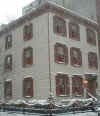 |
If you forego Bleecker Street, continue your walk on Grove Street. The secluded intersection of Grove and Bedford streets seems to have fallen through a time warp into the 19th century. One of the few remaining clapboard structures in Manhattan is 17 Grove Street. |
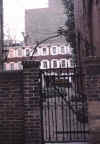
|
Around the same corner is Twin Peaks, an early-19th-century house that resembles a Swiss chalet. Heading west, Grove Street curves in front of the iron gate of Grove Court, a group of mid-19th-century brick-front residences. |
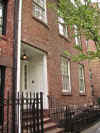
|
Return to Bedford Street, turn right, and walk until you get to No. 86. Behind the unmarked door is Chumley's, a former speakeasy. Continue a couple of blocks farther to the oldest house in the Village, the Isaacs-Hendricks House. |
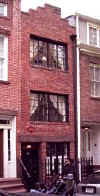
|
The place next door, 75½ Bedford Street, at 9½ ft wide, is New York's narrowest house. Bedford Street intersects Commerce Street, one of the Village's most romantic untrod lanes, and home to the historic Cherry Lane Theatre. |

|
Across the street, past the bend in the road, stand two nearly identical brick houses separated by a garden and popularly known as the Twin Sisters. |
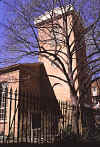
|
Turn left onto Barrow Street and then right onto Hudson Street, so named because this was originally the bank of the Hudson River. The block to the northwest is owned by St. Luke's in the Fields. Writer Bret Harte once lived at 487 Hudson Street, at the end of the row. If your feet are getting tired, you can head north on Hudson Street for four blocks and take a rest at the legendary White Horse Tavern, at 11th Street. |
 |
Two blocks south of Barrow Street, turn left at St. Luke's Place (this is Leroy Street west of Hudson Street), a one-block row of classic 1860s town houses. Across 7th Avenue South, St. Luke's Place becomes Leroy Street again, which terminates in an old Italian neighborhood at Bleecker Street. Because of all the touristy shops and crowds, Bleecker Street between 6th and 7th avenues seems more vital these days than Little Italy does. For authentic Italian ambience, step into one of the fragrant Italian bakeries, such as A. Zito & Sons (No. 259) and Rocco's (No. 243), or look inside the old-style butcher shops, such as Ottomanelli & Sons (No. 285) and Faicco's (No. 260). In a town that's fierce about its pizza, some New Yorkers swear by John's Pizzeria (No. 278), the original in a chain of four branches citywide. Be forewarned, however: no slices; whole pies only. |
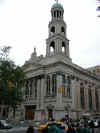
|
Head east on Bleecker Street to Carmine Street and the Church of Our Lady of Pompeii, where Mother Cabrini, a naturalized Italian immigrant who became the first American saint, often prayed. |

|
When you reach Father Demo Square (at Bleecker Street and 6th Avenue), head up 6th Avenue to West 3rd Street and check out the basketball courts, where city-style basketball is played in all but the very coldest weather. Turn down West 3rd Street and check out the illustrious Blue Note, where jazz greats play. The next intersection brings you to MacDougal Street, once home to several illustrious names. The two houses at 127 and 129 MacDougal Street were built for Aaron Burr in 1829; notice the pineapple newel posts, a symbol of hospitality. Louisa May Alcott wrote Little Women while living at 130-132 MacDougal Street. The Provincetown Playhouse at No. 133 premiered many of Eugene O'Neill's plays. |
| Head south on MacDougal to reach Caffe Reggio (No. 119), one of the Village's first coffeehouses. Its interior hasn't changed much since it opened in 1927. At Minetta Tavern (No. 113), a venerable Village watering hole, turn right onto Minetta Lane, which leads to narrow Minetta Street, another former speakeasy alley. Both streets follow the course of Minetta Brook, which once flowed through this neighborhood and still bubbles deep beneath the pavement. The foot of Minetta Street returns you to the corner of 6th Avenue and Bleecker Street, the stomping grounds of 1960s-era folksingers (many performed at the now-defunct Folk City, one block north on West 3rd Street). Partly because of the proximity of NYU, this area still attracts a young crowd to its cafés, bars, jazz clubs, coffeehouses, theaters, and cabarets. |